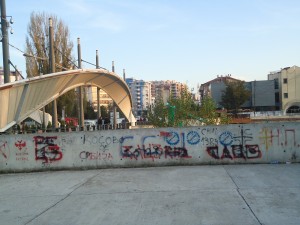
The bridge in the divided town Mitrovica, one of the last places to see fighting between Albanian and Serbian Kosovars.
In my mind, Kosovo is a series of snapshots:
+
There is the bus we took to get here, which has no license plates because vehicles with Serbian plates in Kosovo or Kosovo plates in Serbia might be damaged when left unattended.
+
There is the flag of Kosovo, almost always accompanied by the Albanian flag, the EU flag, and the American flag. Outside of Kosovo’s capital, people display the Albanian and Serbian flags far more often than the national flag of Kosovo, which was designed by Western diplomats after international intervention brought the war here to a standstill.
+
There are KFOR vehicles. One drives through the city. One drives up to a monument, just long enough for the men inside to peer out at the two guards (one is an Albanian Kosovar, the other is a Serbian Kosovar) to make sure they are getting along, and then pulls away. Five of them swarm the checkpoint in front of a 14th Century monastery. The men inside them wear uniforms from Turkey, Italy, and other countries contributing troops to the NATO peacekeeping mission in Kosovo. They are here to keep the peace. They carry machine guns.
+
The bridge in Mitrovica, a city divided between people who are Serb and Albanian by ethnicity but Kosovar by citizenship (kind of–that part’s complicated). This is one of the last towns in Kosovo where you can find a concentrated population of Serbs; it is also one of the last towns to recover from violence. Until this year, our program did not bring students to Mitrovica.
+
Graffiti, where the conflict rages on between Serbs, Albanians, and the international community. Graffiti claiming who belongs where and where Kosovo belongs. Graffiti telling America and the UN to “go home.”
+
A woman sitting out in the rain, a napkin neatly placed in front of her on the ground waiting for donations. A man stops and gives her an umbrella. One woman walks past her, like most people, but turns when she’s half-way up the stairs and returns with coins.
+
A man parallel parking, squeezing his car between two others in front of the restaurant. Another man driving by stops, honks his horn, and uses hand signals to help the first man park. Then he drives away.
+
A student we stop and ask for directions who asks where we’re from and begs us to meet him for coffee and conversation later.
+
Our waiter at a local vegetarian restaurant who remembers exactly what we ordered the night before and tells us it’s okay if we can’t afford the cake on our last night here. “We can just give it to you.”
+
A statue of Mother Theresa (she was born here).
+
The poster of a girl from the city of Peć who is the world champion in Judo. Because Kosovo is not recognized by the UN as a country, she competed in the Olympics as an Albanian.
+Unpaved roads. +Newly built houses. +Gas stations. +The EU flag. +More Albanian flags.
My perception of Kosovo is disjointed. Its people are determined to have Kosovo recognized as an independent country; however, as one politician described it, Kosovo at this moment looks like a “NATO state.” I struggle to understand what it means to be Kosovar–aside from the fact that being Kosovar means struggle. People I listened to define themselves by who they are not, or by who they consider a friend. This is why the flag of Kosovo is accompanied by the flags of Albania, Serbia, the United States, and the EU, among others. The flag of Kosovo on its own is meaningless. Every time I see it, I think I’m seeing the EU flag at first. Based on my impression, that’s all the flag of Kosovo is: a reminder that this state is under international supervision. Without the Albanian or Serbian flag next to it, the Kosovar identity is unstable.
Absolutely I believe that Kosovo has its own identity; I believe that people here can live as Kosovars without the need to assure you they are Serbian or Albanian by ethnicity. They chose to live in Kosovo rather than seek refuge in Serbia or Albania, which to me indicates that something about this state is more meaningful to their identity than the flags of those countries. But the flag of Kosovo does not reflect whatever that identity is. Until Kosovars find a way to express their national identity, the international community will only see the flags of Albania, Serbia, the United States and the EU. The international community will not understand who Kosovars are and why they deserve independence.